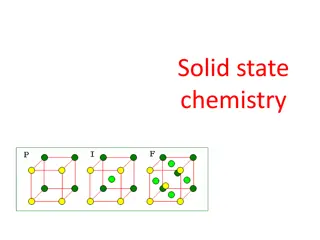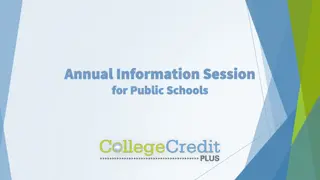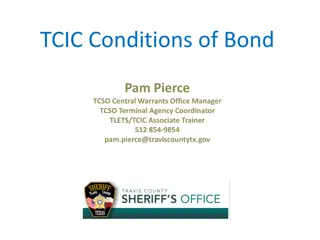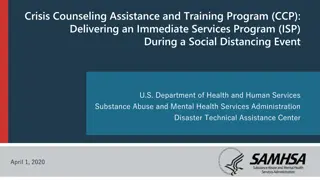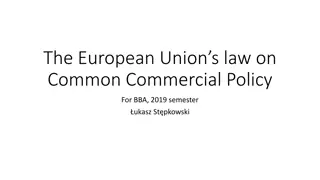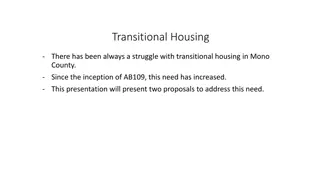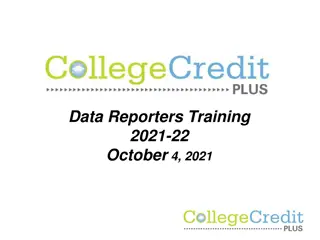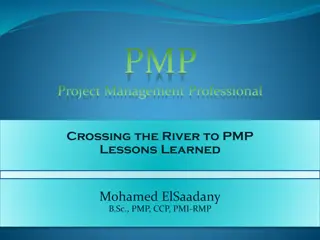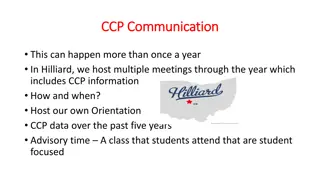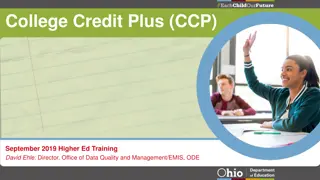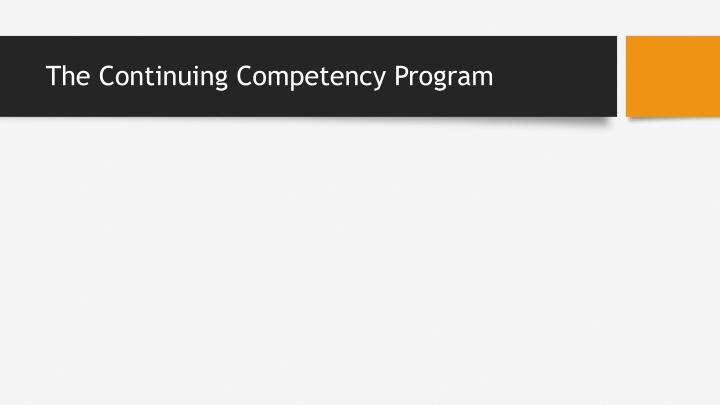
Professional Regulation and Public Protection in Nursing
Professional regulation in the nursing profession involves creating and enforcing standards to ensure safe and competent practice. Regulations protect the public by ensuring only qualified practitioners can engage in nursing, preventing harm, and maintaining high standards of care. Learn about the history and mandate of the College of Licensed Practical Nurses of Prince Edward Island.
Uploaded on | 0 Views
Download Presentation

Please find below an Image/Link to download the presentation.
The content on the website is provided AS IS for your information and personal use only. It may not be sold, licensed, or shared on other websites without obtaining consent from the author. If you encounter any issues during the download, it is possible that the publisher has removed the file from their server.
You are allowed to download the files provided on this website for personal or commercial use, subject to the condition that they are used lawfully. All files are the property of their respective owners.
The content on the website is provided AS IS for your information and personal use only. It may not be sold, licensed, or shared on other websites without obtaining consent from the author.
E N D
Presentation Transcript
The Continuing Competency Program The Continuing Competency Program
Self-Regulation What does it mean to be regulated? Professional regulation is the process of creating, monitoring, and enforcing regulations for the purposes of establishing standards of conduct for the members of a profession. Once developed, the standards for a regulated profession create a framework from which those who work in the profession practice.
What are Regulations? For the nursing profession, regulations are: Rules, policies, principles and guidelines which represent safe and competent nursing practice, and; Minimal standard of education, practice, behavior and conduct which: Promote good practice (desired practice); Prevent poor practice (practice to avoid), and; Intervene when practice is unacceptable (triggers action when practice follows below expectation).
How Regulations protect the public The primary purpose of regulation is protection for the public Certain professions (such as nursing) perform work that if it is carried out in a negligent or fraudulent way or by ill-prepared practitioners, it can be dangerous to the public or contrary to public interest Regulation means processes are put in place so only individuals who have met the requirements of the profession may engage in its practice and those engaged in practice must continue to meet the expected standard of practice The public is protected because only qualified practitioners can enter and remain in the profession.
History of the CLPNPEI The Licensed Nursing Assistant Act proclaimed in 1988 allowed self regulation of LPNs, established the Prince Edward Island Licensed Practical Nurses Registration Board(PEILPNRB) The PEILPNRB was continued as the College of Licensed Practical Nurses of Prince Edward Island in April 2018 under the Regulated Health Professions Act (RHPA) and Licensed Practical Nurse Regulations
CLPNPEI Mandate as per the Regulated Health Professions Act (RHPA) To carry out its activities and govern its members in a manner that serves and protects the public interest
College objects CLPNPEI s functions (objects) are outlined in the Regulated Health Professions Act (RHPA) There are six Broad categories: 1. Registration 2. Practical Nursing Education 3. Practical Nursing Practice 4. Continuing Competence 5. Investigation/Discipline 6. Communication and Collaboration
Self-regulation is important Self-regulation involves licensed practical nurses regulating their practice in the best interest of the public LPNs earn public trust by creating, monitoring, and enforcing their Standards of Practice and Code of Ethics as part of the self- regulatory process Maintaining public trust and confidence is why self-regulation is vital
Self regulation is a Privilege A level of professional status comes with achieving the authority to self-regulate, and by doing so, represents the confidence placed in the practical nursing profession by the government to manage itself and do the right things to ensure the public is protected
Self-regulation is a privilege To keep the privilege, self-regulated professions are accountable to the public and the government to consistently satisfy their objectives of public safety The practical nursing profession could lose the privilege of self- regulation if it was believed the public safety objectives (outlined in the RHPA are not being met
Being regulated versus Self-regulation The regulatory body(CLPNPEI) regulates the practice of LPNs by developing, implementing and enforcing: Regulations (Standards of Practice and Code of Ethics) which represent safe and competent nursing practice, and; Processes (registration, CCP, discipline) ensures those entering and remaining in the profession can provide safe and competent nursing services. LPNs participate in self-regulation by ensuring their practice is consistent with the regulations and taking action when it is not.
The role of CLPNPEI CLPNPEI s role is to govern its members in a manner that serves and protects the public interest. CLPNPEI is responsible to manage the day to day activities of self-regulation by regulating the practice of LPNs through the development, implementation and enforcement of: regulations and (Standards of Practice and Code of Ethics) which represents safe and competent nursing practice, and; processes (registration, CCP, discipline) which ensure those entering and remaining in the profession can provide safe and competent nursing services
How CLPNPEI serves and protects the public CLPNPEI protects the public by promoting the provision of safe, competent, ethical and compassionate nursing services by LPNs CLPNPEI meets its mandate of public protection through regulatory functions such as: Developing registration and licensing processes Setting, monitoring and enforcing standards for practice, professional conduct and continuing competence Setting monitoring and enforcing standards for those entering the profession and PN education, and; Approval of PN education programs 1. 2. 3. 4.
Decision Making CLPNPEI manages the day to day activities of self-regulation, however, decisions about the overall direction of practical nursing are made by the Council of the CLPNPEI The Council is responsible to make decisions about the strategic direction of CLPNPEI and the practical nursing profession, as well as ensure CLPNPEI activities meet its mandate as outlined by the RHPA.
Decision Making The Council is responsible to appoint an Executive Director (ED) and Registrar The ED is accountable to manage the day to day operational and regulatory functions as directed by the Council The Council is made up of: Six LPN s nominated from and by registered licensed practical nurses and appointed by the Minister and; Three public representatives appointed by the Lieutenant Governor in Council. The ED and Registrar are non-voting members.
The Council governs in the public interest by; Strategic Planning and Leadership: A plan to ensure CLPNPEI will accomplish its objects and make effective use of its resources Using a sequential process which includes creating a vision, analyzing internal and external conditions, and identifying the steps for closing the gap between where we are and where we want to be over time
The Council governs in the public interest by Policy Governance: Operational processes, procedures, tools, supports and resources to help achieve the vision outlined in the strategic plan The Executive Director, as authorized by the Council, is accountable to use the above as necessary
How it all fits together... The RHPA Authorizes LPNs to self-regulate and allows for the creation of CLPNPEI as the Regulatory Body for LPNS. The Council sets the strategic direction of CLPNPEI and makes decisions about self-regulation and LPN practice in the best interest of the public. The CLPNPEI manage the day to day activities of self-regulation on behalf of LPNs to ensure public safety. The Executive Director and Registrar implement and evaluate the Council decisions about regulation and public safety
How do individual LPNs self-regulate? LPNs in PEI self-regulate through their engagement with and participation in regulatory activities such as: Self-assessment of their individual competence and capacity and taking action when gaps are identified Becoming a Council member Serving on an CLPNPEI committee, or; Acting as a subject matter expert and providing perspective or feedback on practice documents, policies or member surveys. LPNs also self-regulate by practicing within the framework (Standards of Practice and Code of Ethics) as developed and approved by CLPNPEI
What is continuing competence The ongoing ability of a health care provider to integrate and apply the knowledge, skills and judgement, required to practice safely and ethically in their practice context.
How is competence maintained? Competence is maintained through an ongoing reflective practice evaluation of professional learning activities where new knowledge is integrated into current practice for the expressed purpose of improving nursing practice and client outcomes
Ongoing reflective evaluation Improved Practice & Client Outcomes Learning Activity Reflective Evaluation Apply Learning to Practice Reflective Evaluation Reflective Evaluation
What is a professional learning activity? Any learning activity which results in the acquisition of new nursing knowledge leading to: A greater understanding of the LPN Standards of Practice and Code of Ethics; Enhanced nursing practice, or; Improvement in client outcomes.
Why reflect on our Standards and Code of ethics? Learning activities should reflect elements of the Standards of Practice and/or Code of Ethics because these represent the minimal expectations of safe and competent practice of LPNs in PEI. To maintain nursing competence specific to a practice setting, learning activities should be directly related to nursing and the current practice environment.
What is reflective practice? Reflective practice/reflective evaluation, is a continual process where the nurses analyze and evaluate their own professional experiences as a means of personal learning. Reflective practice helps the nurses to identify what was important about new information learned from an experience so they can apply it in future similar situations.
What is the goal of Reflective Practice? Reflective practice or self-reflection can help the nurses gain insight into their overall nursing practice. Reflective practice helps nurses think about their practice, learn and apply new knowledge so they continue to make safe and competent care decisions.
Why is reflective Practice important? Reflective practice is a critical component of continuing competence because competence cannot be maintained if there is no ability to understand and apply new knowledge in the practice setting. It allows nurses to re-shape what they are doing, while they are doing it.
When do I reflect? Most nurses engage in reflective practice when they encounter a new or challenging situation or when they are self-assessing their learning or practice needs. However, nurses can engage in reflective practice at any time.
How do I reflect? The process is personal, some ways include: Journaling writing Verbal talking with a mentor Thoughtful reasoning internal processing
How do I reflect on my nursing practice? It may be helpful to ask yourself reflective questions to start the reflective process... 1.What does a competent practical nurse need to know? Compare your current practice to a list of practice standards to identify any learning needs. 2.What do I need to know to be a competent practical nurse? Compare a current practice issue to a past experience as a means to identify a current or future learning need. 3.What would a competent practical nurse do? Compare a current practice issue to a past experience as a means to make a practice decision about the current issue. Evaluate your ongoing learning. What else do I need to learn to remain competent?
Why is Continuing Competence important? Continuing Competence is an essential component of professional learning practice. Public interest is best served when nurses constantly improve their application of knowledge, skill and judgement (competence). Continuing Competence promotes good nursing practice, assists in preventing poor practice, and contributes to the quality of nursing practice and best possible client outcomes. Continuing Competence supports practical nurses to make nursing care decisions based on nursing and health care evidence.
Why is continuing competence important? Continuing Competence is an important part of being a self- regulated professional. Continuing Competence requires nurses to: - reflect on their practice in relation to the changes occurring in society and the health care environment, and; - take action to acquire and develop new knowledge to support safe, competent, ethical and compassionate nursing practice.
What is a CCP Program? CCP is a formal process of assessing the continuing competence of a practitioner. Essentially, it is a quality assurance mechanism. Its goal is to contribute to public protection by ensuring LPNs are engaging in learning with reflective evaluations as a mechanism to support their ongoing competence in their practice.
Why is CCP necessary? Public Assurance The CCP provides a level of assurance to the public that LPNs remain competent to practice Legislative Requirement The CCP is one process utilized by CLPNPEI to make sure its members have the necessary ongoing competence to provide safe, ethical, competent and compassionate care
Continuing Competence Program Connection to Standards Participation in the CCP is an obligation for every LPN in PEI. The obligation to engage in regular self-assessment, ongoing learning and reflective practice is embedded in the LPN Standards of Practice and Code of Ethics.
CCP Programs are not new... Most jurisdictions in developed countries have an expectation that nursing professionals maintain their competence throughout their careers. Most self-regulated health professions in Canada have a CCP for their members. Some jurisdictions have had programs in place for over 10 years.
CLPNPEI CCP Program Participation in the CCP has been a mandatory condition of registration since 2018 and our first audit process will be implemented in 2020. Every LPN holding a certificate of registration to practice (regardless of employment status) in every practice setting is required to participate in the CCP every year.
CLPNPEI CCP... LPNs who do not participate in, or are non-compliant with the CCP requirements, will only qualify for a 90-day provisional registration and must demonstrate proof of participation in order to receive a general registration. The CCP must be completed every year in context with maintaining sufficient practice hours.


